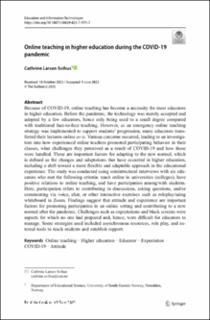| dc.description.abstract | Because of COVID-19, online teaching has become a necessity for most educators in higher education. Before the pandemic, the technology was merely accepted and adopted by a few educators, hence only being used to a small degree compared with traditional face-to-face teaching. However, as an emergency online teaching strategy was implemented to support students’ progression, many educators transferred their lectures online as is. Various concerns occurred, leading to an investigation into how experienced online teachers promoted participating behavior in their classes, what challenges they perceived as a result of COVID-19 and how those were handled. These are important factors for adapting to the new normal, which is defined as the changes and adaptations that have occurred in higher education, including a shift toward a more flexible and adaptable approach in the educational experience. The study was conducted using semistructural interviews with six educators who met the following criteria: teach online in universities (colleges), have positive relations to online teaching, and have participation among/with students. Here, participation refers to contributing in discussions, asking questions, and/or commenting via voice, chat, or other interactive exercises such as roleplay/using whiteboard in Zoom. Findings suggest that attitude and experience are important factors for promoting participation in an online setting and contributing to a new normal after the pandemic. Challenges such as expectations and black screens were aspects for which no one had prepared and, hence, were difficult for educators to manage. Some strategies used included asynchronous resources, role play, and external tools to teach students and establish rapport. | en_US |

